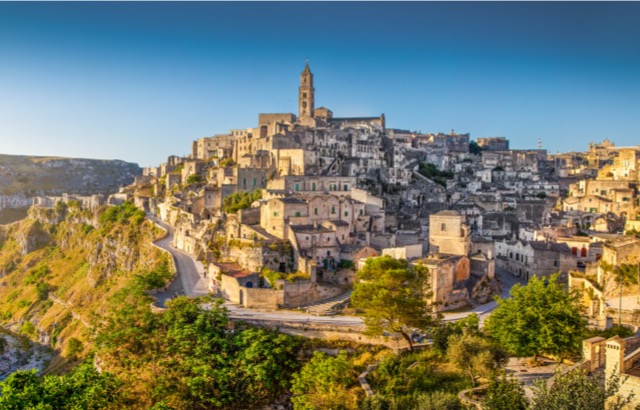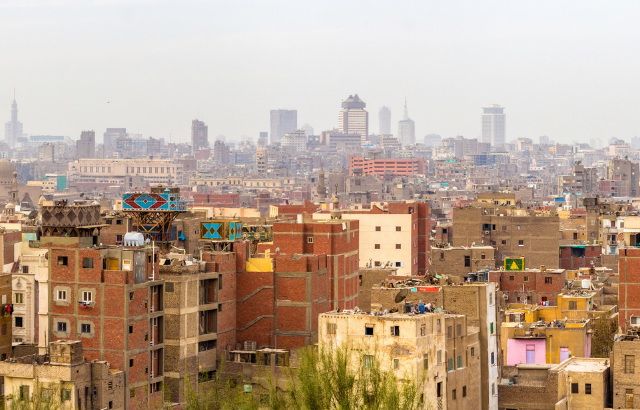Look to our history and the developing world for solutions to climate change
“It’s our last chance” - UN Secretary-General António Guterres.
With COP26 in full motion in Glasgow this week, our Senior Policy Fellow Farida Fortune argues that the industrialised Global North should look to our history and the developing world for solutions to climate change.

The ancient town of Matera pictured at sunrise
First, let’s get some context. There are 197 signatories assembled at COP26, and we know that they are telling us its urgent to introduce new climate change policies and legislation. However, with the tailwind of a global emergency in Covid-19 and with over 30,000 in person attendees, are the speeches and talking going to be enough?
Now let’s focus on the outcome. The task is to agree a rule book to tackle climate change that can be implemented globally. But historically rule books don’t work: unless you have a highly motivated group with a shared vision of single outcome prepared to put political and personal agendas aside.
At COP26 there are two zones, each housing two entirely different groups, UK-green zone, and UN blue zone; does this signal that we already have a split conference? The ethos of both groups must complement the other, or we will be back to an unworkable agenda, making it impossible to have a feasible and deliverable program.
How did we get here?
Understanding how we got here is key. Our four Climate Change Briefs illustrate the pathway of previous COP summits. The 1992 UN Rio Earth Summit agreed to stabilise greenhouse gas concentrations in the atmosphere but 30 years on, what have we achieved since then?
The Kyoto Protocol in 1997 aimed to decrease harmful emissions by 2012: this did not happen. Similarly, with the Paris agreement in 2015 a limit was agreed for a maximum global warming to 1.5 degrees Celsius above pre-industrial temperatures.
A key milestone to achieve these goals involved channeling $100billion to developing nations or ‘other’ states to assist in mitigation and adaption to climate change. Only by working together can we achieve change as these examples of global cooperation illustrate.
The poorest and most disadvantaged take the brunt
We are now feeling the full effect of one of the most devastating global crises in recent times, with COVID infection rates remaining significant on an international scale. Is this fair? 51.3% of the world population has received at least one dose of a COVID-19 vaccine. We know that 7.36 billion doses have been administered globally, and 27.83 million are now administered each day. But….only 4.4% of people in low-income countries have received at least one dose!
Watching the news night after night there are terrible images of fires, flooding, infection, parched earth, and erosion, or water pollution by large multinationals.
Every time and everywhere you look it’s the poorest most disadvantaged taking the brunt!
If we turn our thinking caps around and take our blinkers off, we can then look at how others perceive their world and adapt. We can become one group instead of two, each respecting that the other has a voice.
Learn from how the ‘others’ live
As the industrialised Global North urgently seeks solutions and consensus on climate change, should we instead be looking to our history and the developing world for practical, existing solutions?
For example, what about Egypt’s Zabbaleen or ’garbage people? Around 60,000 of them are scattered across Cairo and collect rubbish from the population, 80% of which is recycled: contrasting with 46% in the UK. Good we say, we should learn from them. After the Egyptian government side-lined them by giving huge contracts to garbage companies – resulting in dirtier streets and a group threatened with rehousing on the edge of the desert – they are once again part of Cairo’s official waste collection system.
In the Global South plastic bottles are often a precious commodity. In places where the climate is desert or semi-desert, or newly affected by soil erosion caused by drought and flash floods washing away topsoil, bottles filled with either stones or sand anchor the soil and form a windbreak. Plastic bottles can also be repurposed to bring light to the poorest parts of the world, avoiding indoor air pollution and other hazards created by candles or kerosene lamps.
Precious plastic bags scavenged from garbage make excellent liners in rough hessian bags keeping the water from evaporating and cool, they even make waterproof shelters and furniture!
A huge amount of energy is currently used to either heat or cool homes. Energy-efficient homes can be built using standards such as Passivhaus so that they maintain an almost constant temperature, but simpler existing solutions already existed long before the development of these standards.
Consider the cave dwellings in Matera in southern Italy, many of which have been transformed into hotels, or the troglodyte houses of Matmata in Tunisia, which provide protection against the summer heat and winter winds: perhaps better known in the Global North as Luke Skywalker’s childhood home in the Star Wars films.
Above-ground air circulation and energy efficiency reviews can take inspiration from building methodology used in ancient Mesopotamia, which incorporated natural cooling elements such as courtyards.
People in many places in the world already experience extreme temperatures, yet lead useful productive lives, and as the Global North warms we can learn from them. For example, layering clothing traps air and keeps the ambient temperature next to the skin bearable, and we can practice night-time or ‘Mediterranean’ purging to keep our homes cooler in summer.
We have amazing technology already available including 3D technology developed originally in Dentistry with the mathematical modelling initially done at Queen Mary University of London. By using recyclable raw earth, an energy saving of over 70% is made.
In medicine, new medication can easily be made by repurposing drugs in current use and exploiting known additional properties or using AI to repurpose medications, with huge fiscal savings. We have forgotten that many of our current drugs were originally repurposed from indigenous populations.
The challenge of perspective
The problem is that the $100 billion on projects is allocated by developed nations from the perspective of industrialised countries in the Global North, but we all have a huge amount to offer.
If we appreciate how others live – their resilience and their adaption to the changes wreaking havoc with the environment – we can learn how to work and live together.
Yes, use global technology to facilitate local ‘technologies’ to contribute to the solutions but have one group: all of us. One collective voice or ubuntu is much needed in this conversation, which may yet save us all.
